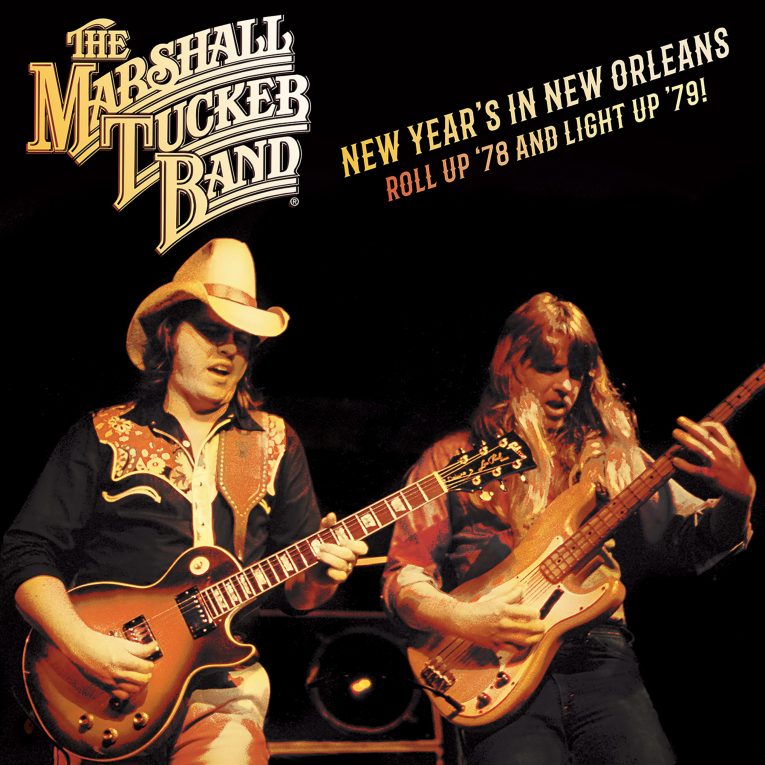
By Kevin Porter
The Marshall Tucker Band is nearing its 50th anniversary, and in commemoration, the band dug through its vaults to release this gem of a live album, New Year’s in New Orleans: Roll Up ’78 and Light Up ’79. Recorded before a rowdy audience on New Year’s Eve in 1978, the concert was simulcast on over 150 radio stations across the country, making it the most listened-to concert at that time.
The album features the band’s classic line-up—Toy Caldwell on guitar; his brother Tommy on bass; George McCorkle on rhythm guitar; Doug Gray on vocals; Jerry Eubanks on saxophone; flute and keyboards; and Paul Riddle on drums. Showcasing superb musicianship and great songwriting, New Year’s in New Orleans: Roll Up ’78 and Light Up ’79 illustrates why The Marshall Tucker Band attracted a legion of fans.
The band was at its full height of musical powers when this concert took place, and they easily blended country, jazz and blues during this hour-and-a-half long concert. Starting with “Fly from the Eagle,” from Carolina Dreams, the band settles into an easy country swing, accented by Eubanks’ flute playing. Eubanks takes the first solo, showing his jazz and soul influences, before giving way to Toy Caldwell, who turns in the first of many Jerry Garcia-meets-Dickey Betts solos that were Toy Caldwell’s hallmark. He was known for playing guitar with his thumb and no pick. This technique created the fat and clear tone that’s his signature sound.
The band’s country influences show up prominently throughout the record. After apologizing to the crowd for a hoarse voice, Toy Caldwell led the band through an impassioned rendition of “Can’t You See.” Eubanks’ opening flute line is one of the classic riffs in rock and roll, but interestingly, it almost became a sax line. Eubanks and Gray decided to go for something different after they saw Jethro Tull in concert and realized the flute would be a more unique sound in rock and roll than the saxophone. You can feel the emotion in Toy’s voice when he sings the song, and it becomes obvious why “Can’t You See” is a sing-along anthem for Marshall Tucker’s fans.
The Marshall Tucker Band was a jam band before the term became a part of the popular lexicon, and their jamming skills are in full display on this album. They play “Ramblin’ at breakneck speed. Gray shouts and croons throughout the song—think Wilson Pickett or Otis Redding with a hard charging country-rock band behind them. Just when the band holds a note and you think the song is about to end, the band changes key and they charge ahead. Gray ends the song with a multi-octave vocal embellishment that brings the house down.
The band also does a 13-minute rendition of “24 Hours at a Time,” with Gray trading notes with Toy Caldwell. They slow the tempo to a crawl at the mid-point of the song, with Eubanks playing a soulful, searching solo on saxophone, before the band breaks loose, hits the accelerator, and speeds towards the song’s final minutes.
The Marshall Tucker Band itself is still thriving, although sadly, some of the original members that shone brightly are gone. Tommy Caldwell died in a car crash in 1980, while Toy passed away at the all-too-young age of 45 in 1993 from cardiac arrest. George McCorkle followed in 2007 after battling cancer. Eubanks and Riddle retired from the band in the 1990s, but Doug Gray is still carrying on, leading the latest edition of the band.
The Marshall Tucker Band still plays over 100 shows a year and recently announced a tour with Charlie Daniels that will start in April. For those of you who wished you saw this band with the original line-up—and I count myself as one—this record will take you back to that night in New Orleans.
The Marshall Tucker Band Online

Saw in Clearwater last night and they were awful. Gray can’t hit a note anymore and the band is little more than a cover band. Couple that with having to Gray’s ignorant political rant and you’re in for one horrible evening. Wish some of these old rockers who can’t bring it anymore would just hang it up!
Saw them in Cleveland last night…all I can say is DON’T GO!! They were horrible, couldn’t sing any longer,it’s sad to see a rock group still try to hang on long after the talent has gone…only saving grace was Dave Mason!! He rocked, marshall tucker should be embarrassed to be in the same venue!! Do NOT waste your money
Unfortunately, I have to agree. Doug Gray was not all there or, if he was, it’s time to “head on down the line”. He was awful at The Pabst Theater in Milwaukee last Thursday, March 3rd. The band was decent. I can’t help from feeling embarrassed for the other band members. He ruined the evening. Dave Mason on the other hand was just great. What a fine musician and band. Kudos to him!
Saw them in Tucson 3/19. Awful.
Schenectady 5/14/22 one word awful.